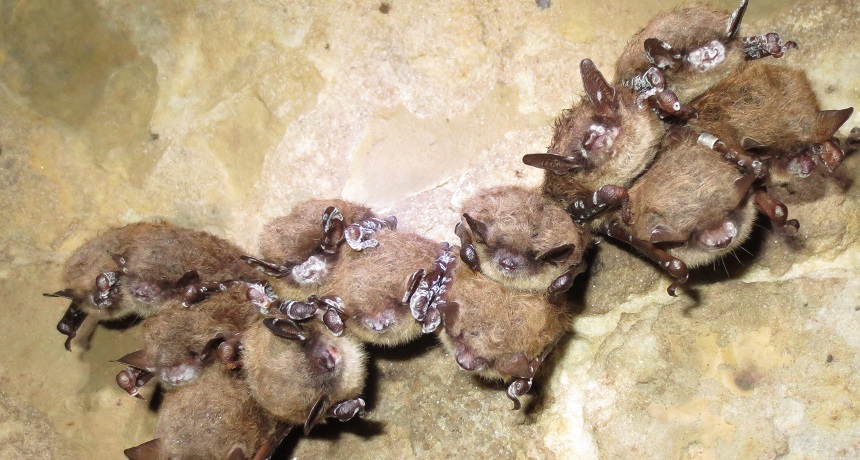Picture This: Winter brings white noses
These bats are suffering from white-nose syndrome, a nasty fungal infection

What looks like a dusting of powdered sugar on these little brown bats is actually a fungal disease. It risks pushing these flying mammals toward extinction.
J.R. Hoyt
Share this:
- Share via email (Opens in new window) Email
- Click to share on Facebook (Opens in new window) Facebook
- Click to share on X (Opens in new window) X
- Click to share on Pinterest (Opens in new window) Pinterest
- Click to share on Reddit (Opens in new window) Reddit
- Share to Google Classroom (Opens in new window) Google Classroom
- Click to print (Opens in new window) Print
Bat populations in the eastern United States and parts of Canada are plummeting. Every winter, large numbers of these flying mammals hibernate in caves. While there, a large share can become infected with a fungus. It triggers a disease known as white-nose syndrome. During the summer, new data show, some bats seem to be able to fight their way free of the disease. The new study points out just how dramatically white-nose infections can emerge and then disappear again over the course of a year.
Scientists could eventually use such information to schedule the best time to treat infected bats.
The fungus is known as Pseudogymnoascus destructans (SU-doh-JIM-no-AS-kus de-STRUK-tans). Until recently, it had another name, Geomyces destructans. It evolved in Europe, recent research found. European bats get white nose, but it doesn’t kill them. The disease only spread to North America around 2006. Because North American bats have yet to build up any resistance to the disease, they can die trying to fight off the infection.
Most nonmigrating North American bats hibernate from November through April. As they do, their body temperature drops to save energy. Because the white-nose fungus grows best at low temperatures, hibernating bats are vulnerable.
When these animals finally rouse from hibernation, their body temperatures spike back to normal. Soon, they are too warm for the fungus to grow.
Kate Langwig and other scientists at the University of California, Santa Cruz, studied six species of bats that get white nose. Throughout the year, they swabbed the wings and faces of these animals in the wild. During summer, most bats completely rid themselves of the fungus, their data now show. But the fungus waits out the season in the caves. So when the animals return in the fall to hibernate, they risk becoming infected again. The scientists published their findings December 3 in the Proceedings of the Royal Society, Biological Sciences.
This new information on how bats fight the fungus in summer — only to become reinfected when they next hibernate — might help scientists protect the animals from the disease. Currently, there is no way to treat white-nose syndrome in hibernating bats. But when research does find a treatment, wildlife biologists now know they will need to apply it after the bats start hibernating. If they try to treat bats during the summer or fall, there may no longer be any infection present.
Power Words
fungus (plural: fungi) One of a group of single- or multiple-celled organisms that reproduce via spores and feed on living or decaying organic matter. Examples include mold, yeasts and mushrooms.
hibernation A state of inactivity that some animals enter to save energy at certain times of year. Bears and bats, for example, can hibernate through the winter. During this time, the animal does not move very much, and the use of energy by the body slows down so that it does not need to eat.
infection A disease that can spread from one organism to another.
resistance (as in disease resistance) The ability of an organism to fight off disease.
white-nose syndrome A fungal disease affecting bats. The fungus, Pseudogymnoascus destructans, lives in caves where bats hibernate through the winter. It causes a white dusting on their noses and on other areas of the body. The fungus causes dehydration and can eat holes through bats’ wings and blood vessels. Eventually, it weakens them, leaving them unable to fly and find food.







